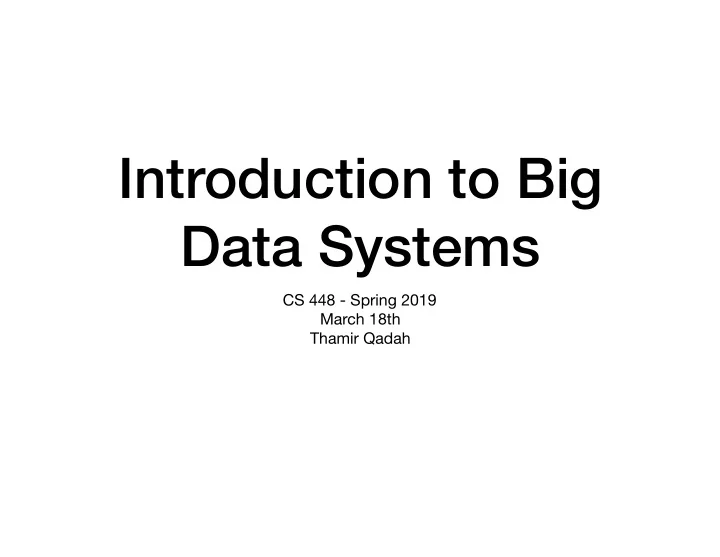

Introduction to Big Data Systems CS 448 - Spring 2019 March 18th Thamir Qadah
Overview • Discussion on: • Motivation for Big Data • The MapReduce Model • Hadoop distributed file system • Spark data processing framework • Think-Pair-Share Sessions, given a few discussion question: • 2 minutes of thinking • 2-4 minutes discuss with partner • 2-4 minutes class-wide discussion
Discussion on Big Data What are the characteristics of Big Data? How are they different from traditional database applications? Why do we need different data management systems for them?
What are the characteristics of Big Data? Volume : Size of data Velocity : Rate of data Variety : Types of data Veracity : Quality of data
How are they different from traditional database applications? Structured Semi- or Un-structured e.g. JSON, XML, e.g. Database tables Images, Videos …
Why do we need different data management systems for Big Data? Traditional DBMSs require some form of ETL Not ideal for certain use-cases (e.g., Build an inverted index of webpages, Page-rank of web-pages) One size does not fit all
Discussion on MapReduce What are the main pieces of logic a programmer needs to specify? What are the benefits of the MapReduce and Hadoop?
What are the main pieces of logic a programmer needs to specify?
MapReduce Model map(K1,V1) : List[K2,V2] reduce(K2, List[V2]) : List[K3,V3]
MapReduce Example What does this code compute?
What are the benefits of the MapReduce and Hadoop? Simple distributed programming Allows for highly parallel and distributed and reliable data processing Free and open source
Discussion on HDFS What are the design goals for HDFS? What are the main architectural components of HDFS?
What are the design goals for HDFS? Fault-tolerance Throughput-optimized Support for large files Append-only data write model
What are the main architectural components of HDFS? Name Node (+ secondary) Data Nodes
Discussion on YARN What is the key concept behind YARN? What are the benefits?
Discussion on YARN Separation of Concerns Improved resource utilization Allow other applications to run on cluster
Zaharia et al. Resilient Distributed Datasets: A Fault-Tolerant Abstraction for In-Memory Cluster Computing. NSDI 2012 Shi et al. Clash of the Titans: MapReduce vs. Spark for Large Scale Data Analytics, VLDB 2015
What are the elements of the vision behind Spark? What is the key feature introduced in Spark 2.0?
What are the elements of the vision behind Spark? Functional High-level API to support data scientists workflows Unified data processing What is the key feature introduced in Spark 2.0? Structured APIs
What technology is better? Parallel Databases MapReduce Structured Data Unstructured Data Fault-tolerance Query Expressiveness Simple Usage Support for Novel Applications
Project 4 Use a real cluster environment (RCAC Scholar) Practice with HDFS Practice with Spark and Spark-SQL (possibly Spark-Streaming too!)
Recommend
More recommend